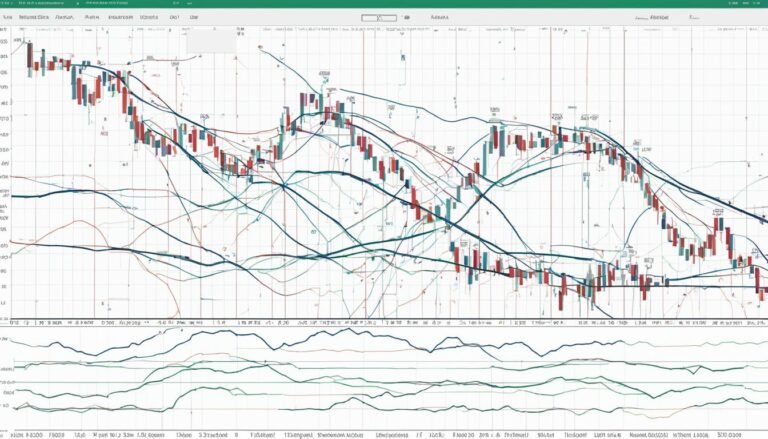Equity Research Fundamentals Explained
Fundamental analysis is a crucial component of equity research, providing investors with valuable insights into the true value of securities. By analyzing economic and financial factors, fundamental analysts assess a company’s intrinsic value, aiding in investment decision-making. This article will delve into the key aspects of equity research and the importance of fundamental analysis in stock analysis, financial modeling, and investment strategies.
Key Takeaways:
- Equity research relies on fundamental analysis to determine the value and potential of securities.
- Fundamental analysis involves examining economic and financial data to assess a company’s intrinsic value.
- Key components of fundamental analysis include economic analysis, industry analysis, and evaluation of company financials.
- Financial statements and regulatory filings are essential sources of information for fundamental analysis.
- Qualitative and quantitative analysis are both integral to fundamental analysis, providing a comprehensive evaluation of a company’s value.
The Importance of Fundamental Analysis in Equity Research
Fundamental analysis plays a critical role in equity research, offering investors valuable insights into the true value of securities. By conducting a thorough evaluation of a company’s financial performance, market trends, and industry conditions, fundamental analysts are able to make well-informed investment decisions. The importance of fundamental analysis becomes particularly evident when it comes to stock valuation, as it provides a solid foundation for determining whether a stock is undervalued or overvalued. This analysis allows investors to maximize their returns and make strategic investment decisions.
Equity research professionals rely heavily on fundamental analysis to understand the underlying value and potential of securities. By examining a company’s financial performance, market dynamics, and industry trends, they are able to generate valuable investment recommendations and provide comprehensive reports. Fundamental analysis enables them to assess the intrinsic value of securities and devise effective investment strategies.
Stock valuation is a critical aspect of fundamental analysis in equity research. By analyzing a company’s financial statements and evaluating factors such as revenue, earnings, growth, and profitability, fundamental analysts can determine whether a stock is overvalued or undervalued. This analysis helps investors make informed decisions based on a stock’s true worth and its potential for future growth.
Investment decisions should never be made solely on market trends or speculation. Fundamental analysis allows investors to base their decisions on tangible data and analysis, providing a solid framework for investment strategies. By considering a company’s financial performance, industry conditions, and market trends, investors can gain a deeper understanding of the risks and potential rewards associated with an investment.
In summary, fundamental analysis is of utmost importance in equity research as it provides a comprehensive understanding of a security’s true value. By evaluating financial performance, market trends, and industry conditions, investors can make well-informed investment decisions based on quantitative and qualitative analysis. Fundamental analysis forms the backbone of stock valuation and plays a crucial role in determining whether an investment has the potential for growth and profitability.
Key Components of Fundamental Analysis
Fundamental analysis is a comprehensive approach that involves evaluating various factors to determine the intrinsic value of a stock. It encompasses economic analysis, industry analysis, and a thorough examination of a company’s financials. By assessing these key components, analysts can gain valuable insights into the true worth of a stock and its potential for future growth.
Economic Analysis
Economic analysis is the first step in fundamental analysis. It involves assessing the overall state of the economy, including macroeconomic factors such as interest rates, inflation, GDP growth, and government policies. By understanding the broader economic landscape, analysts can gauge the potential impact on a company’s operations and profitability.
Industry Analysis
After performing economic analysis, fundamental analysts focus on industry analysis. This entails studying the specific industry in which the company operates, its competitive landscape, market dynamics, and growth prospects. By evaluating industry trends and competitive forces, analysts can assess the company’s position and its ability to capitalize on market opportunities.
Company Financials
Company financials play a crucial role in fundamental analysis. Analysts meticulously examine a company’s financial statements, including the balance sheet, income statement, and cash flow statement. These statements provide insights into the company’s revenues, expenses, assets, liabilities, and cash flow. Analysts analyze financial ratios, such as profitability ratios and liquidity ratios, to gauge the company’s financial health and performance.
Intrinsic Value
The ultimate goal of fundamental analysis is to determine the intrinsic value of a stock. By combining economic analysis, industry analysis, and company financials, analysts can estimate the fair value of a stock based on its earnings potential and growth prospects. This intrinsic value serves as a benchmark for making investment decisions, indicating whether a stock is undervalued or overvalued in the market.
| Key Components | Description |
|---|---|
| Economic Analysis | Assessment of the overall state of the economy, including macroeconomic factors. |
| Industry Analysis | Study of the specific industry in which the company operates. |
| Company Financials | Evaluation of the company’s financial statements and financial health. |
| Intrinsic Value | Determination of the fair value of a stock based on its earnings potential and growth prospects. |
Key Sources for Fundamental Analysis
Fundamental analysis relies on publicly available financial data to evaluate the value of an investment. To conduct a comprehensive assessment, analysts rely on various sources, including:
- Financial statements: Financial statements, such as the balance sheet, income statement, and cash flow statement, provide crucial insights into a company’s financial health. These statements detail the company’s revenues, expenses, assets, liabilities, and equity. Analysts use this information to assess a company’s profitability, solvency, liquidity, and overall financial performance.
- Annual reports: Annual reports offer a comprehensive summary of a company’s financial performance, key achievements, strategic initiatives, risks, and future prospects. They provide valuable information for fundamental analysis, helping analysts gauge a company’s long-term growth potential and overall stability.
- Quarterly reports: Quarterly reports provide more frequent updates on a company’s financial performance. They offer insights into a company’s revenue trends, earnings, and any significant developments or challenges it may have encountered during the quarter. Analyzing these reports allows for a more up-to-date assessment of a company’s financial position.
- 10-Q filings: 10-Q filings are interim reports filed quarterly by publicly traded companies to the U.S. Securities and Exchange Commission (SEC). These filings provide detailed financial and operational information, including unaudited financial statements, management discussion and analysis, and risk factors. They offer a comprehensive view of a company’s financial performance and allow analysts to track its progress over time.
- 10-K filings: 10-K filings are annual reports submitted by companies to the SEC. These filings provide a comprehensive overview of a company’s financial performance, business strategies, risk factors, and corporate governance practices. They include audited financial statements, management discussion and analysis, and other relevant disclosures. Analyzing 10-K filings helps analysts gain a deep understanding of a company’s operations, financials, and competitive position.
Incorporating information from these sources allows analysts to perform a thorough fundamental analysis, providing valuable insights into a company’s intrinsic value and investment potential.
Differences Between Qualitative and Quantitative Fundamental Analysis
Fundamental analysis plays a vital role in evaluating investment opportunities. It can be further categorized into qualitative and quantitative analysis, each focusing on different aspects of a company’s performance and potential.
Qualitative Fundamental Analysis
Qualitative analysis involves assessing non-numerical factors that impact a company’s value and future prospects. These factors include:
- Business Model: Examining how the company generates revenue, its competitive position, and its ability to adapt to changing market conditions.
- Competitive Advantage: Evaluating the unique strengths that set the company apart from its competitors.
- Management Quality: Analyzing the competence and track record of the company’s management team.
- Corporate Governance: Assessing the policies and practices that govern the company, including transparency, accountability, and shareholder rights.
Quantitative Fundamental Analysis
Quantitative analysis focuses on measurable data derived from financial statements to assess a company’s financial performance. It includes:
- Financial Statements: Analyzing balance sheets, income statements, and cash flow statements to gain insights into a company’s financial health.
- Business Ratios: Calculating financial ratios such as profitability ratios, liquidity ratios, and leverage ratios to evaluate a company’s performance and financial stability.
By combining qualitative and quantitative factors, fundamental analysis provides a comprehensive evaluation of a company’s value and investment potential.
To illustrate the differences between qualitative and quantitative analysis, consider the following example:
| Qualitative Analysis | Quantitative Analysis |
|---|---|
| Business Model Assessing the sustainability and scalability of a tech company’s subscription-based business model. |
Financial Statements Analyzing the company’s revenue growth, profit margins, and cash flow from its financial statements. |
| Competitive Advantage Evaluating a pharmaceutical company’s patent portfolio and pipeline of innovative drugs. |
Business Ratios Calculating return on equity (ROE) and earnings per share (EPS) ratios to assess the company’s financial performance. |
| Management Quality Assessing the track record and leadership capabilities of the company’s executive team. |
– |
| Corporate Governance Evaluating the company’s board structure, independent directors, and shareholder rights. |
– |
By considering both qualitative and quantitative factors, investors can gain a holistic understanding of a company’s value and make informed investment decisions.
Core Elements of Qualitative Fundamental Analysis
Qualitative fundamental analysis plays a vital role in evaluating a company’s overall worth and potential. It involves assessing key elements such as the business model, competitive advantage, management team, and corporate governance. Let’s explore each of these core components in detail:
Business Model
The business model is the foundation of a company’s operations and outlines how it generates revenue. It encompasses the strategies, processes, and resources employed by the company to deliver value to its customers and stakeholders. Understanding the business model helps determine its sustainability and profitability over time.
Competitive Advantage
A competitive advantage refers to the distinctive attributes that set a company apart from its competitors. It could be a unique product or service offering, patented technology, economies of scale, strong brand reputation, or effective distribution network. Identifying and analyzing a company’s competitive advantage provides insights into its ability to maintain market dominance and generate long-term profits.
Management
The competence and track record of a company’s management team are crucial factors in determining its success. Assessing the management involves evaluating their experience, expertise, leadership qualities, and strategic decision-making capabilities. A strong management team can drive innovation, execute business plans effectively, and navigate challenges to maximize shareholder value.
Corporate Governance
Corporate governance refers to the system of policies, practices, and processes that govern a company’s operations and ensure transparency, fairness, and accountability. It includes the composition and independence of the board of directors, shareholders’ rights, ethical standards, risk management practices, and compliance with legal and regulatory requirements. Analyzing corporate governance helps assess the company’s commitment to sound business practices and protection of shareholder interests.
By considering these core elements of qualitative fundamental analysis, investors can gain a comprehensive understanding of a company’s strengths, weaknesses, and growth potential. This knowledge forms the basis for informed investment decisions and helps mitigate risk in the dynamic business landscape.
Core Elements of Quantitative Fundamental Analysis
Quantitative fundamental analysis is a key component of equity research, providing valuable insights into a company’s financial health and performance. This analysis focuses on the numerical data derived from financial statements, which include the balance sheet, income statement, and cash flow statement. By examining these core elements, fundamental analysts can assess a company’s profitability, liquidity, and overall financial position.
Balance Sheet
The balance sheet is a snapshot of a company’s financial position at a specific point in time. It provides a comprehensive overview of a company’s assets, liabilities, and shareholders’ equity. By analyzing the balance sheet, fundamental analysts can assess a company’s solvency, financial stability, and ability to meet its financial obligations.
Income Statement
The income statement, also known as the profit and loss statement, presents a company’s revenues, expenses, and net income over a specific period. It provides insights into a company’s profitability and performance, including its revenue generation, cost management, and overall financial health. Fundamental analysts utilize the income statement to evaluate a company’s ability to generate profit and assess its operating efficiency.
Cash Flow Statement
The cash flow statement tracks the flow of cash in and out of a company over a specific period. It details a company’s cash inflows from operating activities, investing activities, and financing activities. The cash flow statement is crucial for assessing a company’s ability to generate and manage cash, its liquidity position, and its capacity to fund future investments and operations.
Financial Ratios
Financial ratios play a significant role in quantitative fundamental analysis as they provide a standardized method for comparing and evaluating a company’s financial performance. Fundamental analysts calculate various financial ratios using data from the financial statements. These ratios include profitability ratios (e.g., gross profit margin, net profit margin), liquidity ratios (e.g., current ratio, quick ratio), and leverage ratios (e.g., debt-to-equity ratio, interest coverage ratio). Financial ratios help assess a company’s efficiency, profitability, liquidity, and financial stability.
By analyzing the balance sheet, income statement, cash flow statement, and financial ratios, fundamental analysts gain valuable insights into a company’s financial health, performance, and potential risks. These quantitative elements provide a foundation for decision-making and investment strategies in equity research.
| Financial Statement | Description |
|---|---|
| Balance Sheet | Provides a snapshot of a company’s financial position at a specific point in time, including its assets, liabilities, and shareholders’ equity. |
| Income Statement | Presents a company’s revenues, expenses, and net income over a specific period, reflecting its profitability and performance. |
| Cash Flow Statement | Tracks a company’s cash inflows and outflows from operating, investing, and financing activities, providing insights into its liquidity and cash management. |
| Financial Ratios | Calculated using data from the financial statements, financial ratios help assess a company’s profitability, liquidity, and financial stability. |
Fundamental Analysis vs. Technical Analysis
When it comes to investment research, there are two prominent approaches: fundamental analysis and technical analysis. Both methods offer unique perspectives on the stock market, utilizing different tools and indicators to make informed decisions.
Fundamental analysis focuses on evaluating a company’s financial performance and industry conditions to determine the intrinsic value of its stock. This approach involves analyzing financial statements, such as balance sheets and income statements, as well as considering qualitative factors like competitive advantage and management quality. By examining historical data and market trends, fundamental analysts aim to identify stocks that may be undervalued or overvalued.
Technical analysis, on the other hand, relies on historical price and volume data to predict future price movements. Technical analysts utilize various chart patterns, indicators, and trend lines to identify market trends and investor sentiment. By analyzing historical data, such as stock prices and trading volumes, technical analysts attempt to forecast potential price movements and determine optimal entry and exit points.
“Fundamental analysis and technical analysis are two different approaches to investment research”
Although fundamental and technical analysis have their strengths and weaknesses, many investors find value in combining the two approaches to gain a more comprehensive understanding of the stock market.
- Fundamental analysis provides insights into the underlying value and long-term potential of a stock. It helps investors identify companies with strong fundamentals and sustainable growth.
- Technical analysis, on the other hand, offers valuable insights into short-term price movements and market trends. It helps investors determine optimal entry and exit points for trading.
By integrating both fundamental and technical analysis, investors can develop well-rounded investment strategies that consider both the intrinsic value of a stock and the timing of market trends.
The table below summarizes the main differences between fundamental analysis and technical analysis:
| Criteria | Fundamental Analysis | Technical Analysis |
|---|---|---|
| Focus | Evaluating financial performance and industry conditions | Analyzing historical price and volume data |
| Tools | Financial statements, qualitative factors | Charts, indicators, trend lines |
| Goal | Determine intrinsic value and long-term potential | Predict short-term price movements and trends |
| Time Horizon | Long-term investment perspective | Short-term trading perspective |
| Strengths | Identify undervalued or overvalued stocks | Identify short-term trading opportunities |
| Weaknesses | Does not capture short-term market sentiment | Does not provide deep insights into company fundamentals |
By combining the strengths of fundamental analysis and technical analysis, investors can make more well-informed decisions, balancing the long-term potential of a stock with short-term market trends.
How Equity Research Professionals Use Fundamental Analysis
Equity research professionals play a crucial role in providing investors with valuable insights and recommendations for their investment decisions. They utilize fundamental analysis, a comprehensive approach that involves analyzing economic factors, industry conditions, and company financials to determine the value and potential of securities. This process allows equity research professionals to produce detailed reports that cover essential aspects such as industry research, management overviews, historical financial results, forecasting, valuation, and investment recommendations.
Equity research reports provide in-depth financial analysis that investors rely on to make informed decisions. By conducting thorough financial analysis, equity research professionals evaluate a company’s financial performance, growth prospects, competitive position, and overall industry dynamics. These reports serve as a valuable resource for investors seeking reliable information to guide their investment strategies.
The Role of Financial Modeling
Equity research professionals also utilize financial modeling techniques to analyze and interpret data. Financial modeling involves creating mathematical models that simulate the financial performance and value of a company. These models allow professionals to perform various analyses, such as sensitivity analysis, scenario analysis, and discounted cash flow analysis. By incorporating financial modeling into their process, equity research professionals can provide more accurate and robust insights into investment opportunities.
Equity research professionals rely on fundamental analysis and financial modeling to analyze investment opportunities and provide investors with valuable insights and recommendations.
Components of Equity Research Reports
| Component | Description |
|---|---|
| Industry Research | An analysis of the industry’s overall performance, trends, and growth prospects. |
| Management Overviews | An assessment of the company’s management team, their track record, and their ability to execute the company’s strategy. |
| Historical Financial Results | An examination of the company’s past financial performance, including revenue, earnings, and profit margins. |
| Forecasting | Projections of the company’s future financial performance based on various assumptions and scenarios. |
| Valuation | An estimation of the company’s intrinsic value using valuation techniques such as discounted cash flow analysis and comparable company analysis. |
| Investment Recommendations | Clear and actionable recommendations for investors regarding the company’s stock, including buy, sell, or hold. |
The combination of in-depth financial analysis, reliable modeling techniques, and comprehensive reports enables equity research professionals to provide investors with valuable insights and recommendations. By leveraging fundamental analysis and financial modeling, these professionals serve as trusted sources of information in the investment community.
The Importance of Combining Fundamental and Technical Analysis
Combining fundamental and technical analysis can greatly enhance investment decision-making. By leveraging both approaches, investors can gain a more comprehensive understanding of the market and make more informed investment choices.
Fundamental analysis provides valuable insights into a company’s intrinsic value and long-term potential. It involves evaluating a company’s financial statements, industry trends, and competitive advantages to determine the fair value of its stock. This analysis helps investors identify companies that are undervalued or overvalued, giving them a solid foundation for their investment decisions.
On the other hand, technical analysis focuses on market trends, price patterns, and trading volume to identify optimal entry and exit points. It helps investors gauge market sentiment and momentum, enabling them to make well-timed trades. Technical analysis complements fundamental analysis by providing insights into short-term price movements and potential turning points in the market.
By combining fundamental and technical analysis, investors can make more well-rounded and strategic investment decisions. For example, fundamental analysis may indicate that a stock is undervalued, but without considering technical analysis, an investor may miss the opportunity to buy it at a favorable price due to unfavorable market conditions.
“The stock market is a device for transferring money from the impatient to the patient.” – Warren Buffett
Timing is crucial in investment decision-making, and by incorporating technical analysis, investors can better time their trades to capitalize on market trends and momentum. The synergy between fundamental and technical analysis allows investors to optimize their investment strategies and potentially maximize their returns.
It is important to note that while combining fundamental and technical analysis can be advantageous, it is essential to conduct thorough research and use proper risk management techniques. Investors should take into account their risk tolerance, investment goals, and time horizon when making investment decisions.
Comparing Fundamental and Technical Analysis
| Fundamental Analysis | Technical Analysis | |
|---|---|---|
| Focus | Company’s financial performance, industry conditions | Market trends, price patterns, trading volume |
| Timeframe | Long-term | Short-term |
| Goal | Identify intrinsic value, undervalued/overvalued stocks | Identify market trends, entry/exit points |
| Information Source | Financial statements, industry research | Price charts, volume data |
By considering both fundamental and technical analysis in tandem, investors can gain a deeper understanding of the market, improve their investment decisions, and potentially achieve better risk-adjusted returns.
Conclusion
Equity research fundamentals play an essential role in helping investors make well-informed investment decisions. By conducting fundamental analysis, investors gain insights into the underlying value of a company, its growth potential, and the dynamics of its industry. This analysis involves a combination of qualitative and quantitative factors, allowing equity research professionals to provide comprehensive reports that guide investors in developing effective investment strategies.
Whether relying on fundamental analysis or incorporating technical analysis, having a strong foundation in equity research fundamentals is crucial for success in stock analysis, financial modeling, and investment strategies in the stock market. Fundamental analysis provides a deep understanding of a company’s financial performance, industry trends, and competitive landscape. It helps investors assess the intrinsic value of stocks and identify potential opportunities in the market.
Equity research professionals use a range of techniques, such as financial modeling, to analyze data and generate insights for their reports. Their expertise in equity research fundamentals enables them to offer valuable recommendations and guidance to investors. Whether novice or experienced, understanding these fundamentals empowers investors to navigate the complexities of the stock market and make informed decisions that align with their investment goals.







